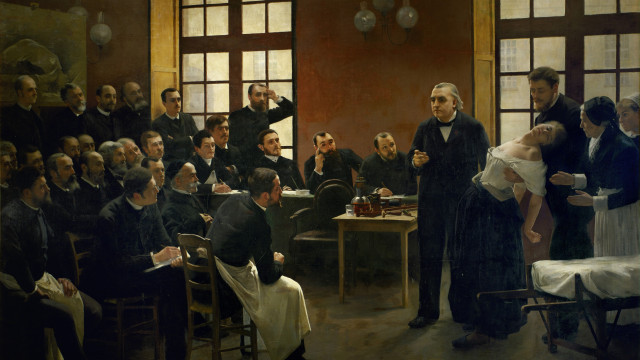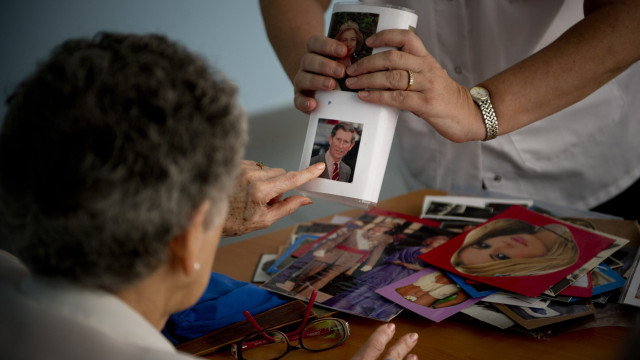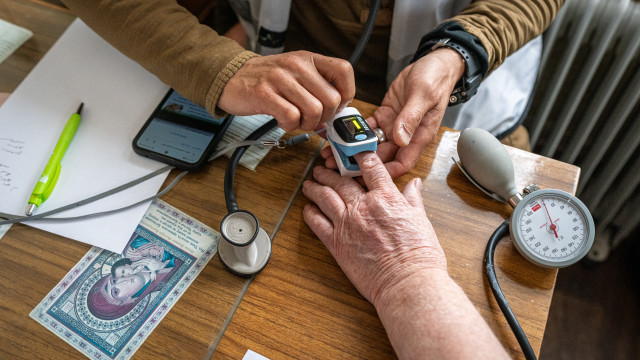






























See Also
See Again
© Shutterstock
0 / 31 Fotos
What is a near-death experience?
- A near-death experience, or NDE, is best described as a profound personal experience with death, or impending death. According to those who claim they've undergone such an actuality, a NDE can manifest itself either as an overwhelming sense of calmness and tranquility, or a dreadful feeling of anguish and despair.
© Shutterstock
1 / 31 Fotos
NDE triggers
- Near-death experiences are triggered during singular life-threatening episodes when the body is injured. For example, by a heart attack.
© Shutterstock
2 / 31 Fotos
Sources of NDEs
- Blunt force trauma such as that sustained in a fall or automobile accident is another source of so-called NDEs.
© Shutterstock
3 / 31 Fotos
Experiences on the operating table
- There have also been reports of patients experiencing near-death episodes while anesthetized and undergoing surgery during life-threatening procedures.
© Shutterstock
4 / 31 Fotos
Waking from a coma
- And some victims of coma have later woken up to recall their own unique NDE.
© Getty Images
5 / 31 Fotos
What is a typical near-death experience?
- These events share broad commonalities. Typically, the victim describes becoming pain-free before departing from their physical self to float above their own body.
© Shutterstock
6 / 31 Fotos
The bright light phenomenon
- Seeing a bright light at the end of a tunnel is an often quoted experience.
© Shutterstock
7 / 31 Fotos
Spatial awareness
- And many near-death experiences have concluded with a sensation of one's self flying off into space.
© Shutterstock
8 / 31 Fotos
Mind over matter
- Why the mind affords such positive and blissful sensations to people in life-threatening and invariably painful situations remains a mystery.
© Shutterstock
9 / 31 Fotos
What part does science play?
- And what about those individuals whose NDEs are anything but tranquil, instead describing them as devastating and even hellish? Whatever the reasons, does science play a part in any of this?
© Shutterstock
10 / 31 Fotos
The neurological standpoint
- For neurologists, some of the answers are straightforward: these so-called near-death experiences have a neural basis.
© Shutterstock
11 / 31 Fotos
Are sleep disorders to blame?
- According to research undertaken at the University of Copenhagen, the sensations associated with a NDE are similar to what goes on in the brain during certain sleep disturbances.
© Shutterstock
12 / 31 Fotos
Sleep paralysis
- The study, reported on by ResearchGate and others publications, suggests that episodes such as bright white light and a deep sense of tranquility are similar in nature to symptoms experienced during a phenomenon known as sleep paralysis.
© Shutterstock
13 / 31 Fotos
Losing control
- The Sleep Foundation describes sleep paralysis as "a temporary loss of muscle control just after falling asleep or before waking up."
© Shutterstock
14 / 31 Fotos
REM sleep intrusion
- The condition is linked to a number of sleep disorders, notably REM (rapid eye movement) sleep intrusion.
© Shutterstock
15 / 31 Fotos
A basis in neurology
- REM sleep plays a significant role in memory consolidation, emotional processing, brain development, and dreaming. Anyone suffering REM sleep intrusion is also susceptible to sleep paralysis. It's why many neurologists believe NDEs have a neurological basis. This theory is reinforced by the fact that sleep paralysis is also associated with certain mental health conditions.
© Shutterstock
16 / 31 Fotos
A terrifying experience
- This feeling of being conscious but unable to move is frequently accompanied by visual or auditory hallucinations, or a feeling of suffocation. It can be a very disturbing experience.
© Shutterstock
17 / 31 Fotos
What about the positive aspects of a NDE?
- While sleep paralysis might explain why some NDEs are negative in nature, how does science explain the positive aspects of a near-death experience?
© Shutterstock
18 / 31 Fotos
Embarking on the right path
- The warmth and serenity associated with a positive NDE is often recalled in vivid detail. But as previously remarked upon, the exact reason why some people are sent down this particular path rather than one that induces fear and anxiety is unclear.
© Shutterstock
19 / 31 Fotos
New sensations
- Additional sensations commonly shared by those who've experienced a NDE include their reviewing of life through a series of vignettes as well as the feeling of an altered sense of time.
© Shutterstock
20 / 31 Fotos
Enhanced senses
- They also speak of increased thought speed, a sense of detachment, and sharper vision or hearing.
© Shutterstock
21 / 31 Fotos
Brain disturbances
- Once again in order to answer at least some of the questions, researchers tend to turn to neuroscience and the effects sleep disorders have on the brain.
© Shutterstock
22 / 31 Fotos
Non-life threatening situations
- While NDEs are complex phenomena, they can also be triggered by situations where someone's life isn't in danger.
© Shutterstock
23 / 31 Fotos
What promotes NDE-like symptoms?
- According to New Scientist, syncope, or fainting, can be enough to promote NDE-like sensations. This assertion, in fact, goes back decades to a 1994 study published in The Lancet that found that fainting encouraged NDE symptoms like feelings of peace, entering another world, and being surrounded by light.
© Shutterstock
24 / 31 Fotos
The benefits of a near-death experience
- Most observers agree that a "good" NDE can have a positive impact on affected individuals. This works on the premise that any threat to one's own existence can lead one to rethink their own life in a better way.
© Shutterstock
25 / 31 Fotos
Life-changing
- Returning from the dead, so to speak, is often reported to be life-changing and spiritually meaningful. Finding out that death can be blissful, and that an afterlife awaits, serves as a comforting revelation to those frightened by the prospect of dying.
© Shutterstock
26 / 31 Fotos
Becoming a better person
- Affected individuals commonly become more reflective, philosophical, and morally upright.
© Shutterstock
27 / 31 Fotos
All you need is love
- A greater desire to cultivate love towards others and to generally be more accepting is another personality trait found in those who've experienced near death.
© Shutterstock
28 / 31 Fotos
Science and faith
- Ultimately, there is room for both science and faith in the same conversation about near-death experiences.
© Shutterstock
29 / 31 Fotos
Transcendental and religious beliefs
- Indeed, some transcendental and religious beliefs about an afterlife include descriptions similar to NDEs. Sources: (University of Copenhagen) (ResearchGate) (Sleep Foundation) (Scientific American) (New Scientist)
© Shutterstock
30 / 31 Fotos
© Shutterstock
0 / 31 Fotos
What is a near-death experience?
- A near-death experience, or NDE, is best described as a profound personal experience with death, or impending death. According to those who claim they've undergone such an actuality, a NDE can manifest itself either as an overwhelming sense of calmness and tranquility, or a dreadful feeling of anguish and despair.
© Shutterstock
1 / 31 Fotos
NDE triggers
- Near-death experiences are triggered during singular life-threatening episodes when the body is injured. For example, by a heart attack.
© Shutterstock
2 / 31 Fotos
Sources of NDEs
- Blunt force trauma such as that sustained in a fall or automobile accident is another source of so-called NDEs.
© Shutterstock
3 / 31 Fotos
Experiences on the operating table
- There have also been reports of patients experiencing near-death episodes while anesthetized and undergoing surgery during life-threatening procedures.
© Shutterstock
4 / 31 Fotos
Waking from a coma
- And some victims of coma have later woken up to recall their own unique NDE.
© Getty Images
5 / 31 Fotos
What is a typical near-death experience?
- These events share broad commonalities. Typically, the victim describes becoming pain-free before departing from their physical self to float above their own body.
© Shutterstock
6 / 31 Fotos
The bright light phenomenon
- Seeing a bright light at the end of a tunnel is an often quoted experience.
© Shutterstock
7 / 31 Fotos
Spatial awareness
- And many near-death experiences have concluded with a sensation of one's self flying off into space.
© Shutterstock
8 / 31 Fotos
Mind over matter
- Why the mind affords such positive and blissful sensations to people in life-threatening and invariably painful situations remains a mystery.
© Shutterstock
9 / 31 Fotos
What part does science play?
- And what about those individuals whose NDEs are anything but tranquil, instead describing them as devastating and even hellish? Whatever the reasons, does science play a part in any of this?
© Shutterstock
10 / 31 Fotos
The neurological standpoint
- For neurologists, some of the answers are straightforward: these so-called near-death experiences have a neural basis.
© Shutterstock
11 / 31 Fotos
Are sleep disorders to blame?
- According to research undertaken at the University of Copenhagen, the sensations associated with a NDE are similar to what goes on in the brain during certain sleep disturbances.
© Shutterstock
12 / 31 Fotos
Sleep paralysis
- The study, reported on by ResearchGate and others publications, suggests that episodes such as bright white light and a deep sense of tranquility are similar in nature to symptoms experienced during a phenomenon known as sleep paralysis.
© Shutterstock
13 / 31 Fotos
Losing control
- The Sleep Foundation describes sleep paralysis as "a temporary loss of muscle control just after falling asleep or before waking up."
© Shutterstock
14 / 31 Fotos
REM sleep intrusion
- The condition is linked to a number of sleep disorders, notably REM (rapid eye movement) sleep intrusion.
© Shutterstock
15 / 31 Fotos
A basis in neurology
- REM sleep plays a significant role in memory consolidation, emotional processing, brain development, and dreaming. Anyone suffering REM sleep intrusion is also susceptible to sleep paralysis. It's why many neurologists believe NDEs have a neurological basis. This theory is reinforced by the fact that sleep paralysis is also associated with certain mental health conditions.
© Shutterstock
16 / 31 Fotos
A terrifying experience
- This feeling of being conscious but unable to move is frequently accompanied by visual or auditory hallucinations, or a feeling of suffocation. It can be a very disturbing experience.
© Shutterstock
17 / 31 Fotos
What about the positive aspects of a NDE?
- While sleep paralysis might explain why some NDEs are negative in nature, how does science explain the positive aspects of a near-death experience?
© Shutterstock
18 / 31 Fotos
Embarking on the right path
- The warmth and serenity associated with a positive NDE is often recalled in vivid detail. But as previously remarked upon, the exact reason why some people are sent down this particular path rather than one that induces fear and anxiety is unclear.
© Shutterstock
19 / 31 Fotos
New sensations
- Additional sensations commonly shared by those who've experienced a NDE include their reviewing of life through a series of vignettes as well as the feeling of an altered sense of time.
© Shutterstock
20 / 31 Fotos
Enhanced senses
- They also speak of increased thought speed, a sense of detachment, and sharper vision or hearing.
© Shutterstock
21 / 31 Fotos
Brain disturbances
- Once again in order to answer at least some of the questions, researchers tend to turn to neuroscience and the effects sleep disorders have on the brain.
© Shutterstock
22 / 31 Fotos
Non-life threatening situations
- While NDEs are complex phenomena, they can also be triggered by situations where someone's life isn't in danger.
© Shutterstock
23 / 31 Fotos
What promotes NDE-like symptoms?
- According to New Scientist, syncope, or fainting, can be enough to promote NDE-like sensations. This assertion, in fact, goes back decades to a 1994 study published in The Lancet that found that fainting encouraged NDE symptoms like feelings of peace, entering another world, and being surrounded by light.
© Shutterstock
24 / 31 Fotos
The benefits of a near-death experience
- Most observers agree that a "good" NDE can have a positive impact on affected individuals. This works on the premise that any threat to one's own existence can lead one to rethink their own life in a better way.
© Shutterstock
25 / 31 Fotos
Life-changing
- Returning from the dead, so to speak, is often reported to be life-changing and spiritually meaningful. Finding out that death can be blissful, and that an afterlife awaits, serves as a comforting revelation to those frightened by the prospect of dying.
© Shutterstock
26 / 31 Fotos
Becoming a better person
- Affected individuals commonly become more reflective, philosophical, and morally upright.
© Shutterstock
27 / 31 Fotos
All you need is love
- A greater desire to cultivate love towards others and to generally be more accepting is another personality trait found in those who've experienced near death.
© Shutterstock
28 / 31 Fotos
Science and faith
- Ultimately, there is room for both science and faith in the same conversation about near-death experiences.
© Shutterstock
29 / 31 Fotos
Transcendental and religious beliefs
- Indeed, some transcendental and religious beliefs about an afterlife include descriptions similar to NDEs. Sources: (University of Copenhagen) (ResearchGate) (Sleep Foundation) (Scientific American) (New Scientist)
© Shutterstock
30 / 31 Fotos
Study reveals science behind near-death experiences
What happens when you decide not to die?
© Shutterstock
The existence of near-death experiences is generally recognized, but not understood. And yet, thousands, if not millions, of people claim to have been affected by this strange phenomenon. For decades, science has been attempting to make sense of what essentially is a variety of often positive sensations that include feelings of levitation and the presence of a bright white light. But a near-death experience can also induce fear, anxiety, and an overwhelming impression of loneliness. So, what's going on?
Is there an explanation out there based on scientific fact, or is there really life after death? Click through and find out if there are any answers.
RECOMMENDED FOR YOU




























MOST READ
- Last Hour
- Last Day
- Last Week








